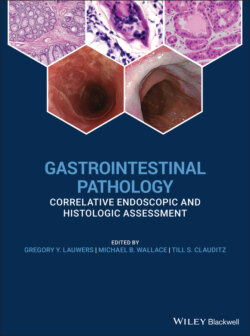Читать книгу Gastrointestinal Pathology - Группа авторов - Страница 21
Specific Organ Sampling Methods Esophagus Diagnostic Sampling
ОглавлениеIndications for diagnostic sampling of the esophagus include Barrett's esophagus and other suspected neoplastic disorders, inflammatory disorder such as eosinophilic esophagitis, gastroesophageal reflux disease, and infectious esophagitis.
The most common indication in Western countries for tissue sampling from the esophagus is likely Barrett's esophagus. There are established guidelines for sampling of the esophagus. These have traditionally been based on the notion that early neoplasia is not visible endoscopically and thus random sampling of the mucosa should be performed to ensure adequate detection of early neoplasia. The most widely used standard is the so‐called Seattle protocol. The American Society for Gastrointestinal Endoscopy (ASGE) guideline for tissue sampling calls for surveillance of nondysplastic Barrett's esophagus in four quadrants every 2 cm with a large‐capacity forceps for the entire Barrett's mucosa. Patients with established low‐grade dysplasia sampling should be more intensive with four‐quadrant biopsies every 1–2 cm. For patients who choose to undergo surveillance for high‐grade dysplasia, sampling every 1 cm should be performed; however, more recent evidence suggests that patients with established low‐grade and high‐grade dysplasia should likely undergo therapy to eradicate the Barrett's esophagus. Advances in endoscopic imaging, such as high‐definition narrow‐band imaging, confocal laser endomicroscopy, and chromoendoscopy, have significantly increased the yield of biopsy and allow much more targeted sampling although these have not yet replaced the need for random biopsy. These advances are likely to reduce the need for random biopsies and focus more on targeted sampling.
For eosinophilic esophagitis the ASGE recommends two to four biopsies from the proximal esophagus and two to four biopsies from the distal esophagus. Biopsy should also be obtained from the gastric antrum and duodenum when diffuse eosinophilic gastroenteritis is suspected.
For suspected infectious esophagitis, multiple biopsies from the margin and base of a visualized ulcer should be obtained and the sample should be sent for standard histology as well as immunohistochemical and possibly viral cultures and PCR. For candidal esophagitis, multiple biopsies of the affected area as well as cytology brushings may be complementary to biopsy.
